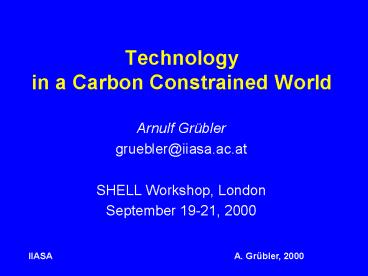Technology in a Carbon Constrained World - PowerPoint PPT Presentation
Title:
Technology in a Carbon Constrained World
Description:
Radical (Hn S): e.g. cheap&clean recovery of methane hydrates; CO2- turbine ... fundamentally new solutions (return to R&D, e.g. closed hydrate - H2 cycles) ... – PowerPoint PPT presentation
Number of Views:63
Avg rating:3.0/5.0
Title: Technology in a Carbon Constrained World
1
Technology in a Carbon Constrained World
- Arnulf Grübler
- gruebler_at_iiasa.ac.at
- SHELL Workshop, London
- September 19-21, 2000
2
Part I Technology and Global Change
- The powers of technology
- Basics of Technological Change III
- Examples for characteristics of TC
dynamic (DRAMS) - systemic (H2 systems)
- cumulative (PVs)
- uncertain (smoke-spark arrestors)
- Hierarchies and rates of change
3
Factors of Growth The Last 200 Years
1800
2000
factor
World population,
1
6
x 6
billion
Life expectancy, years
35
75
x 2
Work hours per year
3,000
1,500
?
2
Free time over life
70,000
300,000
x 4
Mobility, km/day
0.04
40
x 1000
(excl. walk)
World income, trillion
0.5
36
x 70
Global energy use, Gtoe
0.3
10
x 35
Carbon, energy, GtC
0.3
6
x 22
Carbon, all sources,
0.8
8
x 10
GtC
4
Dimensions of Global Change AD 2000
Land
Water
Materials
Energy Carbon
Net source sink
6
2
3
9
3
10
km
km
10
t
10
EJ GtC
Human
47
3.000
lt140
0.4
lt9
7
Natural
84
10.000
lt25
5440
600
--2
as
56
30
560
0.01
1
300
Land - use vs. availability Water - use vs.
surface water runoff Materials - total materials
used (40 Gt) and moved (100 Gt) vs. material
transported by rivers Energy - global primary
energy use vs. solar influx Carbon - sum of
annual exchanges between reservoirs
(bi-directional) vs. gross emissions Source
Turner et al., 1990 IPCC, 1996 Grübler, 1998.
c\leoben\global_change_shell.doc
5
- Technology HSO hardware software
orgware - Most important single factor of productivity and
economic growth - Source and remedy of adverse impacts
- Hierarchical levels of change (increasing size
slower diffusion)
6
Basics of Technological Change II Change is..
- Dynamic importance of both incremental and
radical change (e.g. DRAMS) - Systemic importance of spillovers, clusters, and
systems architecture (e.g. H2 system) - Cumulative increasing returns learning by
doing, but forgetting by not doing (e.g. PVs) - Uncertain risk, but resilience through diversity
and experimentation (e.g. unsuccessful smoke
spark arrestors for steam locomotives)
7
DRAMs
- Key technology for increased computing
performance - Market size 30 billion
- Moores Law holds for gt30 years
(self-fulfilling prophecy) - Density doubles every 18-21 months
1kB to 1GB x106 - Cost decline (/bit) a factor gt100,000 !
8
DRAMS Memory Size
9
DRAMS Prices
10
A Possible H2 System
11
Japan - PV Costs vs. Expenditures
12
Technological Uncertainty Patented but
non-functional smoke-spark arrestors
Source Basalla, 1988.
13
Hierarchy of Technological Change
- Technology Hardware, Software, Orgware
- Incremental (H)
- Radical (Hn S)
- Systems (Hn Sn O)
- Clusters Families (Hn Sn On)
- With increasing hierarchy (complexity)
- larger market size, but slower diffusion.
14
Hierarchies in Rates of Change
15
Part II The GHG Economy Challenges and
Opportunities
- Challenges (e.g. unknown targets)
- Opportunities (e.g. continue decarbonization)
- Opportunities along hierarchy of TC
- An example Towngas strategy
- Implications for SHELL
16
Challenges
- Uncertain targets long-term unknown
short-term not arguable - No easy fix pervasiveness of emissions
(agriculture, energy, industry, land use, sewers,
etc.) - Extreme long time horizon gt100 yrs (act and see
rather than see and act, mismatch between rhythms
of climate change, socio-economic change, and
politics) - Externality not quantified (no binding targets
no price future (ecosystems) damages not
quantifiable damages lt than costs with
discounting dilemma between intra- and
inter-generational equity) - Institutional settings not yet existing (rules
of the game?, who decides?) with contradictory
interests (global -- national dominant --
emerging business)
17
Uncertainties in Stabilizing Climate at 2.5 ºC
by 2100
18
Opportunities
- External support for development of new
technologies, businesses, industries - Innovation trigger (technologies, organizations,
institutions) - Move with, and shape social tide (PR, avoid
worse e.g. hefty C-tax) - Continue historical path of decarbonization
(wood?coal?oil?gas? hydrogen) - New business (revenues and profits) from
- --new products (e.g. fuel cells,
carbon-buckyball structures, CO2 turbines) - --new markets (e.g. CO2 sequestration storage,
towngas CH4 H2) - --new industries (e.g. C as structural
manufacturing material, H2 economy)
19
World Primary Energy Supply
20
World Primary Energy Shares
21
Decarbonization of Global Energy
22
Hierarchies of ChangeT HSO
- Incremental (H) e.g. CO2 capture from CO2-rich
gas reinjection 3-litre car - Radical (HnS) e.g. cheapclean recovery of
methane hydrates CO2- turbine - Systems change (HnSnO) e.g. CO2 market
(sequestration transport disposal) towngas
strategy - Clusters, families, paradigms (HnSnOn) e.g.
H2 economy H2 FC all energy services
consumers utilities
23
An (evolutionary) Towngas Strategy
- Location close to major transit pipelines and
old oilfields (e.g. West Ukraine) - Steam reforming (endothermal - gas later
exothermal - nuclear) - Towngas CH4 H2 (lt30)
- Transport to consumption centers in existing gas
pipelines - Membrane separation (H2?FC CH4?gas turbines
(with CO2 capture)
(C. Marchetti, 1989, Int.J.Hydrog.Energy
14(8)493-506)
24
Methane ? Hydrogen
25
Where to start...
26
Implications for SHELL
- Biggest risk customers and rules still
undefined options involving soil carbon
(forestry) might turn out phoney - Biggest opportunity entirely new business areas,
new dash for gas - Focus short-term 1 capacity building (CO2
trading, CDM, work with sisters, NGOs,
governments) - Focus short-term 2 incremental changes with
positive (even if small) ROI efficiency
improvements (refineries), stop flaring, monitor
plug CH4 leaks (become world leader) - Focus medium-term increase value of gas reserves
(infrastructure investments) towngas strategy - Focus long-term push decarbonization and
hydrogen economy, explore fundamentally new
solutions (return to RD, e.g. closed hydrate -
H2 cycles)































